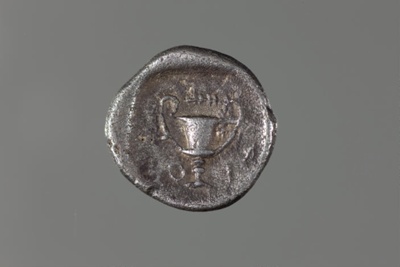< Collection search
< Collection highlights
From:UC Teece Museum of Classical Antiquities
Name/TitleCoin, silver hemidrachm, Boeotia
About this objectThis hemidrachm is worth three obols, or half the value of a drachma. On the obverse side of the coin is a Boeotian shield. Boeotia was a region in ancient Greece. The shield is identifiable by its C-bouts (curved indents) on either side, which would have allowed the user to thrust their sword closer to the shield. This is similar to the standard design of a modern violin, which allows the musician to hold the bow closer to the instrument. The placement of the shield in the corner suggests that the coin was struck roughly. Striking a coin required the worker to hammer a die onto the surface of the coin. The die may have been hammered unevenly onto this coin by accident.
The imagery on the reverse side is more evenly struck. A stemmed kantharos (wine cup) appears in the middle, a club on the left, ivy-leaf on the right and the inscription “BO – I” at the foot, which signifies Boeotia. Many Boeotian coins depicted elaborate vessels such as kantharoi or amphorae on the reverse. Although it is unknown why, the kantharos in particular symbolised the region of Boeotia, much like the owl coins symbolised Athens.
Date MadeEarly to mid 4th Century BC
PeriodLate Classical
Place MadeGreece
Place NotesBoeotia
Medium and MaterialsMetal; Silver
Inscription and MarksBO - I on reverse side, standing for Boeotia (place of mint)
TechniqueStriking (metalworking)
MeasurementsWeight 2.57g
Diameter ca. 15mm
Subject and Association KeywordsInscriptions, Greek
Subject and Association KeywordsPlants in art
Subject and Association KeywordsTableware
Named CollectionThe James Logie Memorial Collection, University of Canterbury, New Zealand
Credit LineDonated by M. K. Steven
Object TypeExchange Media
Object number180.96.4
Copyright LicenceAll rights reserved


